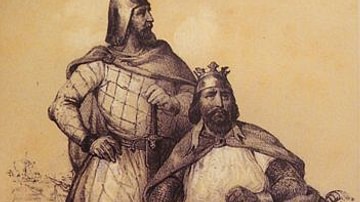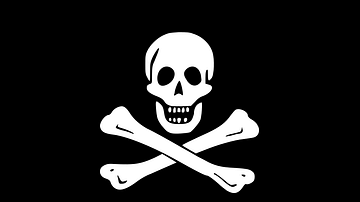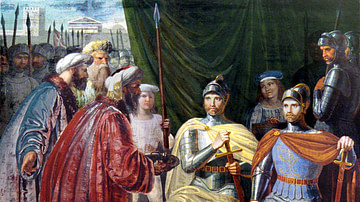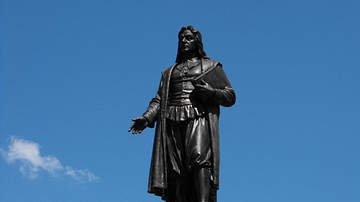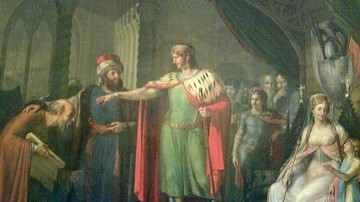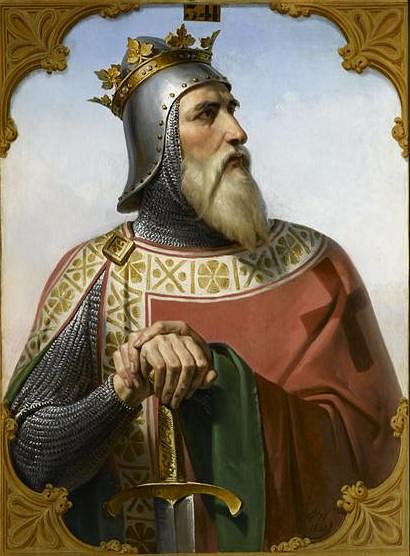
Robert Guiscard (1015-1085) was a Norman knight best known for conquering much of Southern Italy and Sicily during the 11th century. His many exploits include the expulsion of the Byzantines from Italy, support of a reformist papacy, and laying the foundations for a new Norman Kingdom to emerge in Sicily c. 1130.
Family
Robert's father, Tancred de Hauteville (c. 980-1041) was a minor Norman lord most notable for the accomplishments of his twelve sons. In descending chronological order, Tancred's sons by his first wife were William "Iron Arm," Count of Apulia (c. 1042-1046), Drogo, Count of Apulia (c. 1046-1051), Humphrey, Count of Apulia (c. 1051-1057), Geoffrey, Count of the Capitinate (c. 1054-1071) and Serlo. Tancred's second wife Fressenda bore him seven more sons namely, Robert "Guiscard," Count of Apulia (1057-1059), then Duke of Apulia, Calabria, and Sicily (1059-1085), Mauger, Count of the Capitinate (c. 1053-1054), William, Count of the Principate (c. 1055-1080), Aubrey, Tancred, Humbert, and finally Roger, Count of Sicily (c. 1071-1101).
Because Tancred's family was so large and his estate so small, many of his sons decided to look for fame and fortune outside the borders of Normandy. Rumors had been spreading that Southern Italy was rife with political dissension and in need of skilled soldiers. Consequently, many of Tancred's sons including Robert decided to travel to Italy when they came of age, where most of them found remarkable success.
Early Italian Campaigns, 1047-1059
Robert Guiscard's Italian campaigns began around 1047 when he arrived at the court of his brother Drogo, looking for a lordship. Bearing little love for his half-brothers, Drogo initially sent Robert to the more rustic region of Calabria to fend for himself. It was in these early years that Robert gained the reputation of a gifted military commander, earning the epithet "Guiscard," meaning crafty, or cunning. Robert spent these years learning how to survive off the land and his wits.
Surprisingly, Robert excelled during his time in Calabria, making a living by terrorizing the countryside and growing a band of followers eager for plunder. By pillaging the local populace Robert could demonstrate that the Byzantines could not protect their lands, making these regions potentially more amenable to political change. During this time, Robert also found an advantageous marriage alliance with a daughter of the Buonalbergo family, who helped his cause by adding a few hundred knights to his growing entourage. Robert's power and influence continued to expand until 1053 when he was called upon to fight with a Norman coalition at the Battle of Civitate.

A combined Norman force managed to defeat a much larger papal army at Civitate, solidifying Norman rights to recently conquered lands. Furthermore, Civitate established Robert as a preeminent Norman power in the region. Four years later, when Robert's half-brother Count Humphrey died c. 1057, Robert assumed control of his vast estates and title, making Robert one of the most powerful Norman lords in Southern Italy.
It was around this time that Robert, now Count of Apulia, divorced his first wife and entered into a much more politically advantageous marriage to the Prince of Salerno's sister, Sichelgaita (1040-1090). This marriage (c. 1058) was significant in that Robert had married a Lombard princess and was now firmly ensconced as part of the Lombard nobility. This helped Robert gain acceptance as the new ruler of former Lombard lands. Ostensibly, Salerno's ruler Gisulf (r. 1052-1077) and Robert should have been allies, though they would remain at odds with one another for most of their lives. Regardless, the marriage to Sichelgaita helped enhance Robert's reputation and power, both of which continued to mature.
Papal Investiture, 1059
One of the ironies emerging from the aftermath of Civitate was that it actually brought the Normans and papacy closer together. Six years after the battle, the new Pope Nicholas II (r. 1059-1061) was trying to reform the papal election process away from the influence of the lay nobility and into the hands of a select group of cardinals. These reforms were likely to incur the wrath of aristocratic lords and particularly the Holy Roman Emperors who had historically installed papal candidates amenable to their own political agendas.
Nicholas saw in Robert Guiscard and other Norman lords a source of support and protection. Therefore, at the Synod of Melfi on 23 August 1059, Nicholas II formally invested Robert as Duke of Apulia, Calabria, and Sicily, in return for his safeguarding of the Holy See. Robert accepted his new title, making him the most extensive Norman landowner in Italy, barely a decade after his arrival.

The caveat to Robert's investiture was that his duchy was far from pacified. Apulia and Calabria were still claimed by the Byzantines, and all of Sicily was still held by semi-independent Islamic emirates. Undaunted, Robert would spend the next twelve years conquering each of his provinces in turn, beginning with the Byzantine capital of Calabria, Reggio.
Years of Conquest, 1060-1073
Calabria was always a quieter region within Robert's domains, partially due to centuries of Islamic coastal raids, making it less developed and wealthy than Apulia. Robert still needed the strategically important city of Reggio to secure its maritime resources and evict the Byzantines from their Calabrian capital. By 1060, Robert was ready with an army he brought from Apulia to meet up with his younger brother Roger outside the city. Roger had spent the past winter building siege engines and preparing for an assault on Reggio, which fell to their combined forces in early 1060.
From his secured base at Reggio, Robert could launch attacks into Sicily, located just a few miles across the narrow Strait. The most logical bridgehead was Messina, which the brothers managed to take almost completely by surprise in May 1061. From this point forward, the conquest of Sicily would take nearly three decades, mainly because Robert was constantly settling rebellions and uprisings from his jealous Apulian vassals. Consequently, Robert left Roger in his place to subdue the island, while he focused energy and resources on his troublesome eastern frontier. In 1068, after nearly seven years of preparation, Robert was finally ready to attack the source of so much intrigue and trouble in his Apulian lands, the Byzantine city of Bari. The chronicler William of Apulia explains Robert's rationale in the following passage:
His [Robert's] enemies entirely subdued and all their fortresses captured, he prepared to besiege the people of Bari. There was no city in Apulia which exceeded the opulence of Bari. He besieged it, wealthy and strongly-defended, that by overcoming the rulers of so great a city he might therefore terrify and subject the lesser towns, for of all the cities along the Apulian coast Bari was the greatest. The duke furnished his camp with soldiers and filled the sea with ships brought by the Calabrians. (27)
The Siege of Bari, 1068-1071
Bari lay directly across the Adriatic Sea from Byzantine Illyria and so could be easily resupplied with troops and food. The Byzantines were also far more experienced sailors, so the citizens of Bari felt confident they could resist Robert, who was not known for his naval supremacy.
However, Robert had been quietly growing his naval capacity since the early 1060s. His many Calabrian and Apulian port cities provided him with ships and experienced seamen that he now brought to bear. So, it was to the surprise of Bari's citizenry that Robert formed a naval blockade around their harbor. To ensure that no Byzantine ships broke through, he chained his own ships together, so his troops could quickly run from ship to ship to support areas under attack. The siege began on 5 August 1068 and would last for three arduous years. According to William of Apulia:
He [Robert] attacked the city bravely. The inhabitants, by no means reluctant to fight it out, resisted valiantly. He carefully prepared mantlets by the gates under the protection of which he placed armed men in ambush; he prepared a wooden tower to overtop the walls, on each side of which he placed stonethrowers, along with every sort of siege engine which might knock down the walls. Nonetheless the citizens continued to defend their city, nor did they simply remain inside their defences, but went outside the walls to fight the duke. They put his soldiers to flight and their blows cast them down. (28)
Not until Roger arrived in 1071 from Sicily with his own ships was the stalemate broken. Roger defeated and scattered a long-awaited Byzantine relief fleet much to the dismay of the starving citizens in Bari. Afterward, despair spread through the city, as did arguments over whether they should surrender. Ultimately, a faction within the city admitted some of Robert's troops through a gate and it fell soon after. Robert entered Bari on 16 April 1071, symbolically marking the beginning of a new era of rule for Robert's Italian lands.
Robert was not cruel to the citizens of Bari, restoring many estates and properties to those who had been deprived of them. It seems likely that Robert wanted the favor of his new subjects as he immediately planned to march them to Sicily, where they would help him take his next target, the city of Palermo.
The Siege of Palermo, 1071-1072
11th-century Palermo was a beautiful and wealthy metropolis experiencing something of a golden age. The historian John Julius Norwich describes the city in the following way:
In the middle of the eleventh century Palermo was one of the greatest commercial and cultural centres of the Muslim world. Cairo doubtless exceeded it in size; Cordova may have outshone it in magnificence; but for beauty of situation, perfection of climate and all the broad range of amenities which together constituted the characteristic Arab douceur de vivre, Palermo was supreme. (176)
Palermo would be a rich prize for Robert, but it would also take a substantial and dedicated force to conquer such a wealthy and valuable target. Just six months after taking Bari, Robert was outside the walls of Palermo reading to begin yet another siege.
Robert did indeed bring a large army and his navy to blockade resupply by sea. The contemporary chronicler Geoffrey Malaterra describes the storming of the city in the following passage:
For five months the enemy kept up a keen and vigilant defence of the city. He (Robert) and his brother were nonetheless determined to attack it, and he watched eagerly for an opportunity to storm it… After most skilfully constructing siege engines and ladders to scale the walls, the duke stealthily entered the gardens on the sea side where the fleet was, along with three hundred knights, intending to storm the city. He instructed his brother to do the same thing on the other side where he was. On his signal the men he led acted speedily and forced their way in with a great cheer… A section of the wall which they had not been worried about had been foolishly left unmanned; Guiscard's men placed their ladders there and scaled it. The outer city was captured, and the iron gates were opened for their comrades to enter. The duke and count, with their whole army, took up position inside the walls. (62)
After a brave defense, the city surrendered to Robert on 10 January 1072. Thus was captured the most lucrative possession in Sicily, though much of the island still remained unconquered. At this point, Robert made Roger Count of Sicily, leaving him to subdue the remaining Islamic emirates. Robert would remain in Palermo for most of 1072, helping to reconfigure the administration of the city's existing government, which would run much as it had before.
Robert Guiscard's Rule
One of the defining features of Robert's rule was his relatively lenient policies toward the subjects of his conquered lands. Even his rebellious vassals in Apulia found remarkable tolerance in the wake of their various uprisings. The conquest of Bari and Palermo was no different, as Robert allowed the government of these cities to continue with few changes.
Palermo, for instance, was permitted self-government under the existing system prior to the Norman conquest. Islam could still be practiced, and Islamic law was still honored for those adhering to the Muslim faith. Furthermore, Robert generally respected the lives, properties, and rights of Palermo's inhabitants. He naturally demanded an annual tribute and fealty from its citizens, but in an age of harsh justice, especially after a city had fiercely resisted, he was relatively fair and balanced in his proclamations.
This was mainly because the Normans did not come as settlers to their conquered lands but as a ruling elite. As such, they needed the cooperation and acceptance of their subjects, without which they would have had difficulty maintaining their territorial gains. Both Robert and Roger especially were sensitive to the fact that they ruled ethnically diverse multicultural realms with various customs and traditions. By honoring these often contradictory viewpoints, many of Robert's subjects could continue with business as usual, without undergoing the full economic and social upheaval often associated with conquest by an incoming foreign power. This not only stabilized trade and the rule of law but made the transition of political power more palatable to his new vassals.
Further Conquest, 1073-1085
Upon returning to Italy c. 1073, Robert would quell yet another uprising from his unruly barons with a characteristic light hand. The political climate in Italy changed somewhat in 1073 with the election of Pope Gregory VII (r. 1073-1085), and Robert would need all the support he could get. Like Nicholas II, Gregory was a papal reformist, though perhaps of a harsher disposition. Excommunicated twice by Gregory, Robert managed to survive the political turmoil of the 1070s, even acquiring his wife's childhood home of Salerno in 1076. From this new capital, Robert began planning for his next military adventure.
An ambitious man undeterred by age, Robert devised a casus belli to invade and perhaps conquer the Byzantine Empire itself in 1080, beginning with the Greek city of Dyrrhachium across the Adriatic Sea. The Byzantine princess and chronicler Anna Komnene (1083-1153) disparages Robert's ambition in the following passage:
For now they recognized Duke Robert's aim, and saw that he had occupied the plain of Illyria, not for the purpose of pillaging towns and country, collecting a large store of booty, and then returning to Apulia, as rumour [sic] had reported, but that he was really striving for the mastership of the Roman Empire, and was anxious to take Dyrrachium by storm, to start with, so to say. (Book IV. I.)
Robert and his sons found considerable success attacking the Byzantines on their home turf from 1081-1085. However, the Normans seem to have met their match with the new Byzantine Emperor, Alexios I Komnenos (r. 1081-1118), who managed to reverse many of the gains made by Robert's armies. Perhaps to the relief of Alexios and the province of Illyria, Robert died of fever en route to Cephalonia on 17 July 1085, aged 70 years old.
Legacy
Robert Guiscard's legendary success may best be understood as a product of his military acumen coupled with a sage tolerance for dissension. Perhaps, his relatively lenient reprisals were born of necessity, being that he needed the support of his rebellious barons for future conquests and maintaining stability over newly conquered lands. Regardless, he had managed to stitch together an area that was almost hopelessly fractured into a cohesive, cosmopolitan political unit in just a few short years. The historian John Julius Norwich sums up Robert's legacy in the following few lines:
Robert had found South Italy a confusion of races and religions, of principalities, duchies and petty baronies, all of them endlessly, pointlessly at loggerheads; he left it welded together into a single state…As for his personal valour, the most revealing proof is given by William of Malmesbury, who tells of how Duke William of Normandy—the Conqueror—used to screw up his own courage by reminding himself of the Guiscard's; and indeed in their achievements the two greatest Normans of their time had more than a little in common. (249)
Ultimately, Robert and his Norman kinsmen helped completely shift the balance of power on the Italian Peninsula in the 11th century. Expelling the Byzantines, supporting the papacy, and dealing with the Holy Roman Emperors as he saw fit, Robert had established himself as a new focal point of European power in Southern Italy. Through his vast energy, military prowess and force of personality, Robert's endless ambitions helped bring a sense of stability to an unstable realm.






